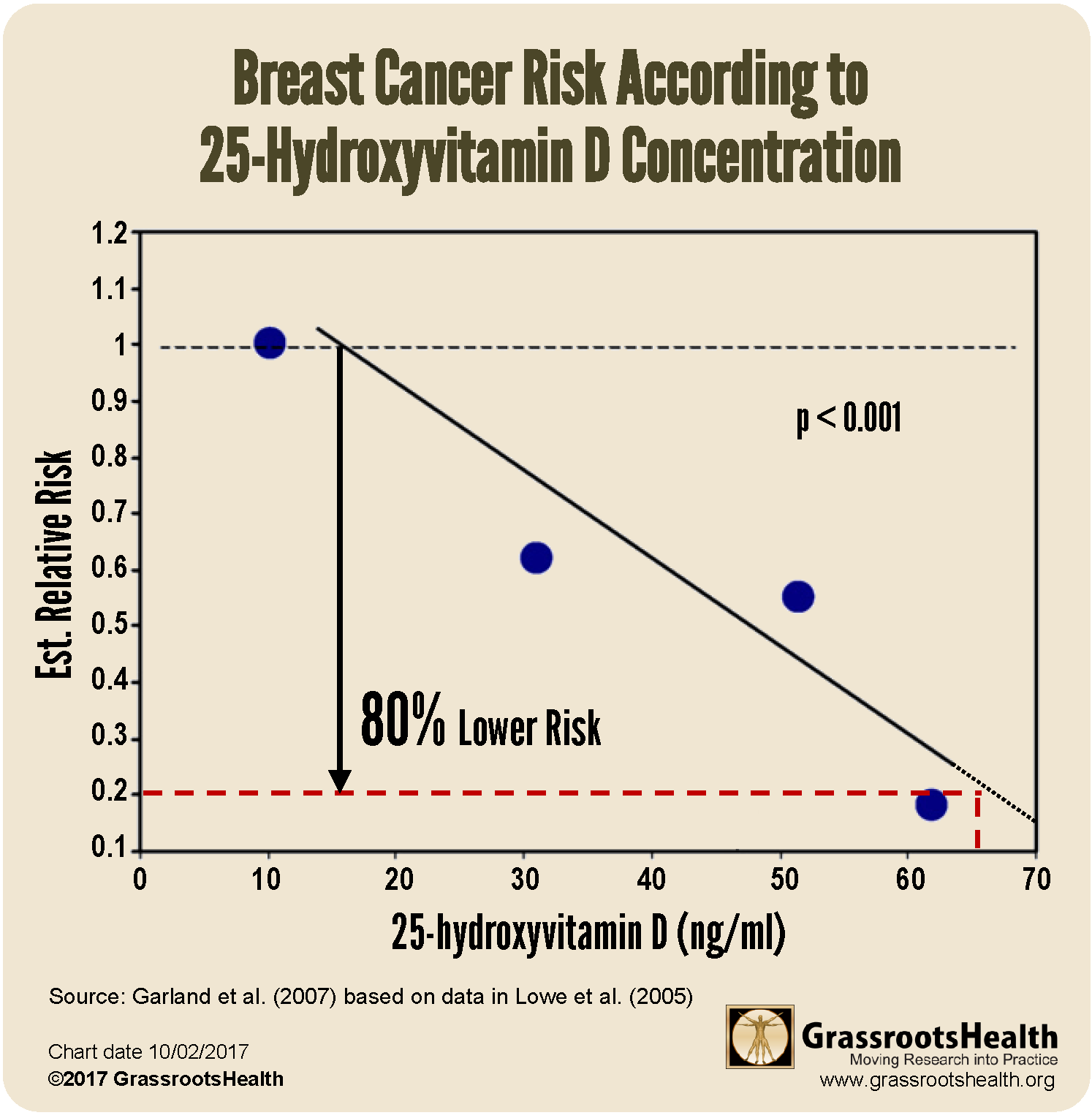Published on October 17, 2018
We all want to eliminate breast cancer. It has touched most every life and is a brutal disease – the diagnosis, the treatment, and possibly death.
But where should we give our money to make the most impact?
Breast cancer prevention is possible
Let’s start by setting the stage. It is possible to donate towards breast cancer prevention (not just awareness), yet most organizations spend the money on 1) advertising and outreach (read: getting more donations) 2) Studies for treatments (read: more drug trials) or 3) Helping families with cancer (read: driving to appointments, support groups, etc.).
While all of these goals are worthy, we wouldn’t even need #2 and #3 if there were no breast cancer, so GrassrootsHealth focuses on cutting breast cancer off before it starts.
We feel confident focusing 100% on prevention because we work with researchers and have known, since 2007, that there is a correlation between vitamin D and breast cancer incidence. (Incidence is the fancy word for getting breast cancer in the first place).
Here are two graphs of this correlation:


If you are rusty from too much time away from your math classes, what these graphs say is that as you increase your vitamin D levels (the horizontal or x-axis, going from left to right) you decrease your risk of breast cancer (the vertical or y-axis, going from high to low). There are many more of these graphs and studies, a good summary is on our Breast Cancer Prevention Project web page.
Can vitamin D prevent breast cancer?

Yes!
We know that levels above 60 ng/ml (150 nmol/L) could prevent 80% of breast cancer. You might think that this should be the number one priority for all breast cancer organizations.
If we had $10M and focused on vitamin D, we would hit the bullseye…
What do the big breast cancer organizations spend their money on?
The chart below is from information available on the Internet (see references).
| Susan G. Komen | Breast Cancer Research Foundation (BCRF) | National Breast Cancer Coalition (NBCC) | American Cancer Society (ACS) | |
|---|---|---|---|---|
| Charity Navigator (highest rating is ****) | *** | *** | *** | ** |
| % Giving Spent on Programs | 79% | 89% | 82% | 58% |
| 2017 Revenue | $147M | $73M | $2.8M | $808M |
| 2017 Spending on grants | 43% | 79% | 20%* | 49% |
| 2017 spending on research | $50M | $51M | $560K | $230M |
| How they recommend prevention | “…there is no one behavior that will prevent breast cancer.” | No blanket recommendations. | No tobacco No sun Eat healthy Get active HPV vaccine Screenings & tests | |
| Research solely on prevention | 12% of all research spending is on prevention 5% total $2.5M | Could not find | Could not find | 54% of all research |
| Money spent on vitamin D and cancer research | $ 0 | $ 0 | $ 0 | $ 0 |
*2016 number from annual report
These big companies have missed the mark! The research is there that one nutrient could make a colossal change in the landscape and they have all neglected to investigate it. Their dartboard looks like this:

What do these organizations’ view of prevention look like?
Susan G. Komen’s view on prevention
Susan G. Komen’s depicts prevention with a picture of a beautiful, young mother holding her toddler. Both are happy and healthy. They educate women that there are factors they can and cannot effect. For example, they can’t change whether or not they are a woman or their age.
Then, they make the boldest misinformed statement in the breast cancer industry, just eight short paragraphs from the top:
“…there is no one behavior that will prevent breast cancer.”
What?
There is ONE key behavior, getting vitamin D serum levels above 60 ng/ml, that could prevent 80% of breast cancer. This should be priority #1.
Breast Cancer Research Foundation
BCRF is similar to GrassrootsHealth. They fundraise solely to grant researchers money to study breast cancer. Because of this, they do not give any blanket recommendations and you truly have to search their web site to find any recommendations.
So, hats off to BCRF for letting the research speak for itself!
National Breast Cancer Coalition
NBCC has set a deadline of 2020 to “know how to end breast cancer.” That is a lofty goal and we support them 100%. We would say that a good way to get there would be to start NOW with a community project on vitamin D. In the two years until 2020 we can enroll women, test their D levels, raise them above 60 ng/ml and record the results.
But sadly, as with most of these big organizations, they do not invest in vitamin D.
GrassrootsHealth would agree with their truth # 29 from their 31 myths and truths about breast cancer, “I can educate myself.” The 10,000 people who have participated in our field trials have educated themselves on vitamin D, and tested to find out where they stand. . We need more people to educate themselves, to take action for themselves and not wait for the doctors to act.
American Cancer Society’s view on prevention
American Cancer Society has a prevention web page with six main categories or pictures. Of these, three are based on medical vaccines, tests, or screenings. Two are natural preventive measures – stay away from tobacco and eat healthy & get active. Their other preventive measure is to be safe in the sun, with a picture of a child being slathered in sunscreen.
Nowhere is vitamin D mentioned, and while we do agree with the importance of sun safety and not burning, they are unwittingly contributing to keeping vitamin D levels low by focusing on sunscreen use and sun avoidance.
But I like to walk, what should I do?
All of these organizations are trying to make the world a better place and they do help many people.
To ensure your donation dollars and your efforts go toward breast cancer prevention, you may consider either
- Donating to GrassrootsHealth. Your funds go 100% toward prevention. With $3M we could provide grants to organizations to do a Field Trial vitamin D program in their community. This program is the Breast Cancer Prevention Project.
- When going to an event such as a walk or a rally, bring copies of this breast cancer brochure and hand it out. Set up a vitamin D table. Create a sign that says, “Vitamin D levels above 60 ng/ml reduce risk of cancer by 80%. What is your level?” and bring copies of this web page so they can go home and test their level.
References
Susan G. Komen
Charity Navigator gives 2017 revenue and spending
Top level Web page gives percentages of Giving
Understanding risk reduction
Breast Cancer Research Foundation (BCRF)
Charity Navigator gives 2017 revenue and spending
Web page gives amount given to research
Resources page – the closest they get to giving advice
National Breast Cancer Coalition
Charity Navigator
Annual Report 2016
31 myths and truths about breast cancer
American Cancer Society
Charity Navigator
Investment by areas of research
Prevention web page
